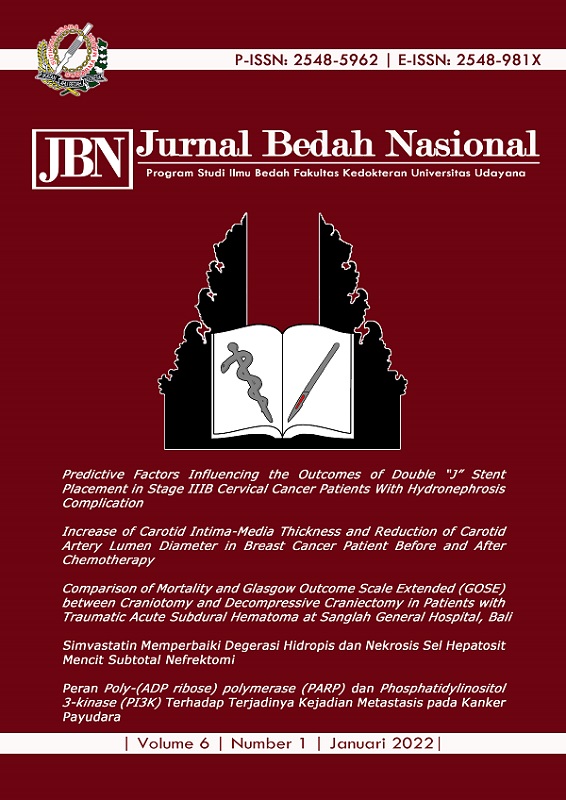Predictive Factors Influencing the Outcomes of Double “J” Stent Placement in Stage IIIB Cervical Cancer Patients With Hydronephrosis Complication
Abstract
Objective: To determine the predictive factors that influence the outcome of Double “J” (DJ) stent placement in stage IIIB cervical cancer patients with hydronephrosis complications. Methods: An analytical observational study with a historical cohort was performed. Patients included in this study was patient with stage IIIB cervical cancer with hydronephrosis complication at Sanglah hospital. We analyzed the influence of time range since diagnosis until DJ stent placement, degree of hydronephrosis, and glomerular filtration rate on the outcomes of DJ stent placement namely: Lower urinary tract symptoms (LUTS), quality of life (QoL), and glomerular filtration rate changes (GFR). Data were tabulated and statistically analyzed using SPSS 25. Results: Of the 44 samples, the mean age of the patients was 51,93 (±7.672) years. Late DJ stent placement increase the risk of severe LUTS (RR: 3.103; 95%CI: 1.319-7.301; p<0.001) compared to patients with early DJ stent placement. We also found that a low glomerular filtration rate (bad renal function) is significantly associated with worse quality of life (RR: 1.917; 95%CI: 1.296-2.835; p<0.001). Conclusion: Delayed DJ stent placement is associated with severe LUTS symptoms, and poor renal function resulted in a poor quality of life.
Downloads
References
2. Goldfarb DA, Poggio ED. Etiology, Pathogenesis, and Management of Renal Failure. In: McDougal WS, Wein AJ, Kavoussi LR, et al, editors. Campbell-Walsh Wein handbook of urology, 10th ed. Philadelphia: Elsevier Saunders; 2012. p.228-32.
3. Hodson CJ. Post-obstructive renal atrophy (nephropathy). Br Med Bull. 1972;28:237-40.
4. Shehab M, El Helali A, Abdelkhalek M, et. al. Role of ureteric stents in relieving obstruction in patients with obstructive uropathy. Urol Ann. 2013;5:148-51.
5. Al-Marhoon MS, Shareef O, Venkiteswaran KP. Complications and outcomes of JJ stenting of the ureter in urological practice: A single-center experience. Arab J Urol. 2012;10:372-7.
6. Miyaoka R, Monga M. Ureteral stent discomfort: Etiology and management. Indian J Urol. 2009;25:455-60.
7. Singh I, Strandhoy JW, Assimos DG. Pathophysiology of urinary tract obstruction. In: McDougal WS, Wein AJ, Kavoussi LR, et al, editors. Campbell-Walsh Wein handbook of urology, 10th ed. Philadelphia: Elsevier Saunders; 2012. p.212-219.
8. Gumilar OB, Soebadi DM, Djojodimedjo T, et al. Oral phenazopyridine HCl for ureter orifice identification and retrograde stenting. Indonesian J Urol. 2015;22:21-7.

This work is licensed under a Creative Commons Attribution 4.0 International License.
Program Studi Ilmu Bedah Fakultas Kedokteran Universitas Udayana. 
This work is licensed under a Creative Commons Attribution 4.0 International License.






